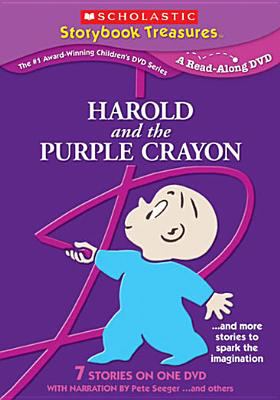The full title of this DVD is Harold and the Purple Crayon…and more stories to spark the imagination. I picked it up from my library because Crockett Johnson’s 1955 Harold and the Purple Crayon is a classic children’s book. More than that, it is a book that foregrounds drawing and the power of drawing. In fact, it is about all the possibilities that can be found in a single crayon, because the whole story is about young Harold, who invents his own adventure, and essentially his whole world, with a single purple crayon. I was curious what it would be like to see an animated version of this story that I remembered so well from childhood.

The answer is, it’s great. Johnson’s simple style fits well with animation, and it doesn’t take much to turn the clear lines of his pictures into equally clear and engaging action. The flow was already there, in the lines Harold used to create roads and walls: now I got to see them come into being and glide across the screen.
I also got to see something else, and realize what I had missed: this DVD has seven stories on it, including two other Harold stories: A Picture for Harold’s Room and Harold’s Fairy Tale. I hadn’t know that Johnson (pen name for David Johnson Leisk) had created other Harold books. I liked the fairy tale most of all, and will be looking for the book version of that story and all other Harold books.
In short, the first three stories on this DVD are a joy and a unified joy. The other four are all strong, and some are classics, but they are very different, in style, content, and tone. The fourth story, for example, is an presentation of Hans Christian Anderson’s story “The Swineherd,” illustrated by Bjorn Winblad. The story is much darker than any of the Harold story, and presents much stronger social critique. The images are lovely, but complex, making it appeal to a much older audience.
The fifth story is an odd adaptation of Robert McCloskey’s Time of Wonder. McCloskey is rightly famous for his Make Way for Ducklings, which won the 1942 Caldecott. This story is a slow-moving, even glacial, presentation of his celebration of the rural and natural world of Maine. This wasn’t animated: it was read aloud, with some sound effects, while the camera scans McCloskey’s images. It’s lovely, and it’s easy to see why it won him a second Caldecott, but the pace makes it unlikely to appeal to modern kids.
Story six changes approach again: The Foolish Frog is built around classic folk singer Pete Seeger singing “The Foolish Frog.” It’s a zany tall tale, ridiculous and catchy. (You can see it on YouTube.) The illustration is cartoonish, which is jarring after the McCloskey’s painted landscape.
The final story, Drummer Hoff, is built around rhyme, and illustrated by the classic children’s illustrator Ed Emberley. It has a strong, developmental rhythm, and lovely images…but it is once again quite different from anything that went before.
All these brief videos are professional. All are striking, and some are classics…but they don’t necessarily fit together.